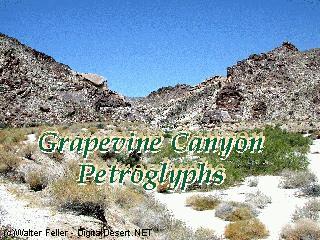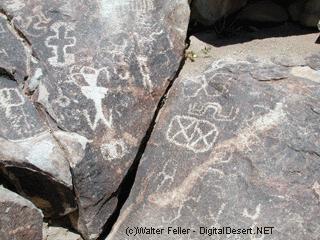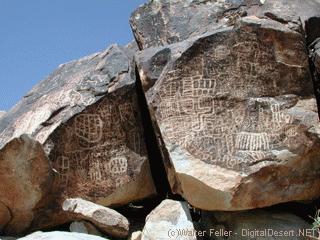--
Grapevine Canyon
 -
- 
Grapevine Canyon is located about five miles outside Laughlin at the base of Newberry Peak in the Newberry Mountains. For thousands of years, the Mojave Indians have called this their homeland. Although it is unknown whether the Mojaves created the panoply of rock art that adorns the cliff sides of what they call Avi-Kwame or Spirit Mountain, it is assumed that they or their Paleo-Indian/Desert Archaic ancestors conceived and fashioned the petroglyphs at the site.
 -
- 
While the Mojaves have not been able to provide a glyph by glyph interpretation of the designs at the site (most likely because of the immense age of the petroglyphs stretching back into prehistory), they have offered a general setting from which to interpret the drawings. The drawings depict Creation Mythology. Every Indian nation possessed a similar Creation Mythology and these societies held it of higher importance than anything in life. For the Mojave, their Creation Mythology depicted the story of such powerful gods as Matavilya and Mastamho who shaped the world, fought off evil spirits, and taught men and women how to survive off the land.
 -
- 
In essence, their Creation Mythology, like the Creation Mythology of all Indian nations, consisted of four main evolutionary phases: early creation, the age of the god-people when spirits ruled, the rise of the animal-people when animals were men, and the conquest of the world by modern human-people. By entering a trance state, the Indian shaman threw himself into the invisible world where all these ancestors of the modern human-people remained imprinted on the fabric of the spirit realm. Then the shaman brought back the images he had seen and re-created them on the surrounding rocks.
 -
- 
In looking at the Grapevine Canyon petroglyphs with this setting in mind, it becomes possible that the individual glyphs were ideograms or symbols that either captured a specific event in this four-fold evolutionary process or signified at what point in this four-fold process a specific event was taking place. That is, the petroglyph designs were the mythological stories in chronological form expressed through ideograms by the Mojave people or their ancestors. As an ideogram, each glyph was infused with meaning on its own, but that meaning was amplified when placed in combinations with other glyphs. Glyphs were either geometric, based on permutations of circles or extensions of lines, or representational, based on humanoids, therianthropes (part-animal, part-human), or animals. At Grapevine Canyon, some of the glyphs can be readily identified with Creation Mythology while others are more difficult to comprehend. The more obvious ones include:
 -
- 
Creation: circles, rayed circles, spirals
God-people: amorphous humanoids with accouterments (ie: solar crowns, snakes)
Animal-people: semi-humanoids with horns or tails
Modern Human-people: male and female genitalia, the squared-cross denoting the sacred number 4 or the idea of completion
 -
- 
There is still much work to be done by scholars in regard to the interpretation of these complex symbols. Fortunately, scholarship in recent years, when faced with the insurmountable evidence that the same glyphs reappear on rocks thousands of miles from one another, has gone beyond the suggestions that the designs on the rocks were indiscriminate doodles.
By Don Shepherd - 17 January 2011

